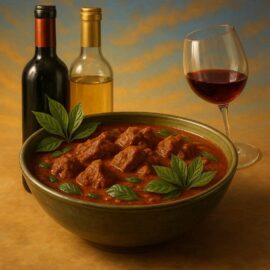Introduction
Andhra cuisine is renowned for its bold, fiery flavors and unapologetic use of spice. Among its celebrated dishes, Andhra Gongura Mutton Curry holds a special place. This dish combines tender mutton with gongura leaves (sorrel/roselle)—a tangy, slightly sour green that defines the regional palate. When paired thoughtfully with wine, this curry opens up exciting opportunities for balancing heat, taming acidity, and highlighting complex flavors.
Dish Name & Cultural Context
Gongura Mutton Curry is a culinary icon of Andhra Pradesh. Gongura, a leafy green with a tart bite, has been used for centuries in Telugu households for pickles, dals, and curries. Its marriage with mutton creates a dish that is both rustic and regal—a staple at festive occasions and Sunday family meals alike.
Key Ingredients & Preparation Style
- Mutton (goat meat) – slow-cooked until tender.
- Gongura leaves – imparting signature tanginess.
- Green chilies, red chilies, ginger, garlic – layers of spice and warmth.
- Whole spices (cloves, cinnamon, cardamom, cumin, coriander seeds) – deep earthy backbone.
- Onions & tomatoes – for body and texture.
The curry is simmered until the mutton absorbs the sharp-sour notes of gongura, resulting in a spicy, tangy, and aromatic dish.
Flavor & Texture Profile
- Spicy heat from green and red chilies.
- Tangy acidity from gongura leaves.
- Earthy depth from whole spices.
- Rich, meaty texture from slow-cooked mutton.
- Medium-bodied curry that is neither creamy nor too dry, but bold and layered.
Science Behind Spice & Wine Interactions
- Acidity in wine mirrors the tang of gongura and keeps the pairing lively.
- Residual sweetness (off-dry wines) can soothe chili heat.
- Moderate tannins are needed for mutton, but high tannins clash with spice.
- Alcohol content: too high makes the chili burn worse; moderate levels (12–13.5%) work better.
Key spice compounds:
- Capsaicin (chili heat) pairs best with slightly sweet or fruity wines.
- Tart organic acids in gongura echo the need for bright, high-acid wines.
- Earthy spice oils resonate with Syrah, Tempranillo, or Indian Sangiovese.
Ideal Wine Pairings: Science & Art of Selection
White Wines
- Sula Riesling (Nashik, India)
- Why it Works: Off-dry sweetness balances chili heat; citrus and floral notes lift gongura’s tang.
- Producers: Sula Vineyards, Nashik Valley.
- Grüner Veltliner (Austria)
- Why it Works: Peppery notes echo Andhra spice; crisp acidity complements gongura’s sourness.
- Producers: Weingut Bründlmayer, Domäne Wachau.
- Albariño (Rías Baixas, Spain)
- Why it Works: High acidity, stone fruit flavors, and saline minerality cut through mutton richness.
- Producers: Bodegas Fillaboa, Pazo de Señorans.
Red Wines
- Fratelli Sangiovese (Maharashtra, India)
- Why it Works: Soft tannins, red cherry fruit, and freshness align with tangy gongura while handling meaty depth.
- Producers: Fratelli Vineyards.
- Syrah/Shiraz (Rhône Valley, France or Barossa, Australia)
- Why it Works: Black pepper and spice notes mirror Andhra flavors; plush fruit balances the sourness.
- Producers: Guigal (Rhône), Torbreck (Barossa).
- Tempranillo (Rioja, Spain)
- Why it Works: Earthy, savory, and tangy red fruit tones play beautifully with gongura and slow-cooked mutton.
- Producers: Marqués de Riscal, La Rioja Alta.
Alternate Wines: Unexpected Pairings
- Lambrusco (Italy) – lightly sparkling, fruity red that cools spice and refreshes the palate.
- Dry Rosé (Provence or Indian rosé) – crisp acidity with subtle fruit, excellent for summer dining.
- Gewürztraminer (Alsace or India’s York Winery) – floral, off-dry, and aromatic, calming chili fire.
Wines to Avoid & Common Mistakes
- High-tannin reds (Cabernet Sauvignon, Nebbiolo): Intensify heat and make the dish bitter.
- Overly oaked Chardonnay: Clashes with sourness of gongura and tastes heavy.
- High-alcohol wines (>14.5%): Amplify chili burn.
Quick-Reference Table
| Mismatched Pairing | Why It Doesn’t Work | Better Alternative | Example Wine | Suggested Wine Reason |
|---|---|---|---|---|
| Cabernet Sauvignon | Harsh tannins + spice clash | Softer red with fruit & spice | Château Ste. Michelle Cab | Fratelli Sangiovese (soft tannins, freshness) |
| Oaked Chardonnay | Heavy oak + sourness clash | Crisp aromatic white | Sonoma Chardonnay | Sula Riesling (fresh, off-dry) |
| Zinfandel (high alcohol) | Increases chili burn | Moderate-alcohol spicy red | Lodi Zinfandel | Syrah/Shiraz (spicy yet balanced) |
Final Thoughts & Expert Tips
Pairing wine with Andhra Gongura Mutton Curry is about balance: acidity for gongura, fruitiness for chili, and moderate structure for mutton. Indian wines like Sula Riesling and Fratelli Sangiovese are especially rewarding, showing how local wines can elevate regional dishes.
Fun fact: Gongura leaves are so beloved in Andhra that households often grow them in backyard gardens, ensuring a steady supply for pickles and curries.
Recipe & Wine-Friendly Adjustments
Ingredients
- 500g mutton (goat)
- 2 cups gongura leaves (sorrel)
- 3 onions, sliced
- 2 tomatoes, chopped
- 5–6 green chilies
- 2 tsp ginger-garlic paste
- Whole spices: cloves, cinnamon, cardamom, cumin
- 2 tsp red chili powder
- 1 tsp coriander powder
- Salt to taste
- Oil/ghee
Preparation
- Pressure cook mutton with turmeric, salt, and half the spices until tender.
- Sauté onions, ginger-garlic, chilies, and spices until golden.
- Add tomatoes, chili powder, coriander powder.
- Stir in cooked mutton and simmer.
- Separately wilt gongura leaves, then blend and add to curry.
- Simmer until flavors meld.
Wine-Friendly Modifications
- Reduce chili slightly if serving with delicate whites.
- Add a touch of yogurt to soften heat for rosé pairings.
- Use whole spices generously for synergy with Syrah/Tempranillo.
Serving Suggestions
- Serve with steamed rice or jowar roti.
- Garnish with fresh coriander.
- Pair with a pre-chilled bottle of Riesling or a lightly cooled glass of Sangiovese.

